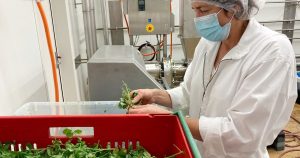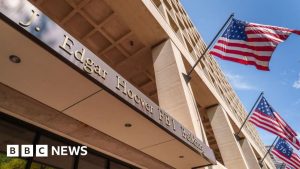

The skin’s extracellular matrix (Olga Zinkevych/Shutterstock)
Major breakthrough advances efforts in regenerative medicine
UNIVERSITY PARK, Pa.— When you press your finger against your skin, the tissue underneath temporarily stiffens to resist the pressure. Cut yourself, and your tissue gradually heals. These seemingly simple responses have proven remarkably difficult to replicate in synthetic materials. Now, researchers at Penn State have made a breakthrough by developing special hydrogels that can actually mimic these complex tissue behaviors.
The human body’s tissues are supported by an intricate scaffolding called the extracellular matrix (ECM). This natural framework provides structural support for cells and helps tissues maintain their shape and function. When pressure or strain is applied to healthy tissue, the ECM responds by becoming temporarily stiffer, a property that helps protect our organs and tissues from damage. Additionally, tissues can repair minor damage through natural healing processes. In a new study published in Materials Horizons, researchers have found a way to recreate these sophisticated biological properties in laboratory-made materials.
“We developed a cell-free — or acellular — material that dynamically mimics the behavior of ECMs, which are key building blocks of mammalian tissues that are crucial for tissue structure and cell functions,” explains corresponding author Amir Sheikhi, associate professor of chemical engineering at Penn State, in a statement.
Creating synthetic materials that can replicate these sophisticated behaviors has proven extremely challenging. Previous attempts using synthetic hydrogels, materials mostly made of water held together by polymer networks, fell short. These earlier versions couldn’t properly mimic the way natural tissues respond to mechanical forces while maintaining the ability to self-heal.


Sheikhi Research Group/Penn State)
“Specifically, these materials need to replicate nonlinear strain-stiffening, which is when ECM networks stiffen under strain caused by physical forces exerted by cells or external stimuli,” says Sheikhi.
The Penn State team solved this problem by developing what they call “LivGels” using an innovative combination of natural materials. They started with alginate, a polymer derived from seaweed, and modified it to create a flexible network. Then they engineered special nanoparticles from modified wood pulp cellulose. These tiny particles, called nLinkers, are rod-shaped with special molecular “hairs” at their ends that can form reversible chemical bonds.
The nLinker particles act like dynamic connection points throughout the gel network. When force is applied to the gel, these connections can temporarily break and reform in new configurations, allowing the material to become stiffer in response to stress. When the material is damaged, these same reversible connections enable self-healing.
Through careful testing, the researchers demonstrated that they could control the gel’s properties by adjusting two key factors: the concentration of nLinker particles and the number of calcium ions added to create additional connection points. This tunability means they can create gels with different levels of stiffness and responsiveness to match various types of human tissue, from soft brain tissue to firmer muscle tissue.


Unlike previous synthetic alternatives that raised concerns about biocompatibility, these hydrogels avoid synthetic polymers entirely. The researchers used specialized testing methods to show that the LivGels could quickly recover their structure after experiencing high strain, confirming their self-healing abilities.
In regenerative medicine, these new materials could serve as scaffolds for tissue repair and regeneration, providing cells with an environment that better mimics natural tissue. For drug development, these materials could create more realistic tissue models for testing new medications. They might also enable the development of improved surgical materials and wound dressings that actively promote healing.
Beyond medical applications, these materials could advance the field of soft robotics, allowing for the creation of robots with parts that can change their stiffness as needed and self-repair when damaged. The technology might also find applications in 3D bioprinting, where these gels could be used to create customized tissue-like structures.
“Our next steps include optimizing LivGels for specific tissue types, exploring in vivo applications for regenerative medicine, integrating LivGels with 3D bioprinting platforms and investigating potential in dynamic wearable or implantable devices,” says Sheikhi.
By successfully mimicking the dynamic properties of natural tissues, these hydrogels open new possibilities for everything from improved medical implants to more realistic disease models. While significant testing remains before clinical use, this advance demonstrates how understanding natural biological systems can drive innovation in materials science.
Paper Summary
Methodology
The researchers developed their hydrogels through a carefully designed process. First, they chemically modified alginate to create a network-forming polymer with special attachment points. Separately, they transformed wood pulp cellulose through a series of chemical reactions to create the nLinker particles, which feature two types of chemical groups that can form reversible bonds. By combining these components in various ratios, sometimes with added calcium ions, they created gels with different properties. They then used specialized equipment to measure how the gels responded to various types of mechanical stress and strain.
Results
Testing revealed that the hydrogels could increase their stiffness when subjected to mechanical forces, similar to natural tissues. They demonstrated rapid self-healing, recovering their properties within seconds after experiencing high strain. Importantly, the gels achieved stiffness values (30-591 Pa) comparable to natural soft tissues, and their properties could be tuned by adjusting their composition.
Limitations
While the results are promising, the research focused primarily on mechanical properties rather than biological interactions. Further studies would be needed to fully understand how these materials interact with living cells and tissues over time. The maximum stiffness achieved was also limited compared to some firmer tissue types.
Takeaways and Discussion
This research presents a new approach to creating dynamic hydrogels using naturally derived components. The materials successfully mimicked key mechanical properties of natural tissues, including strain-stiffening and self-healing. Their tunability and natural composition make them particularly promising for biomedical applications.
Funding and Disclosures
The research was supported by Penn State, including: the Dorothy Foehr Huck and J. Lloyd Huck Early Career Chair; the Convergence Center for Living Multifunctional Material Systems and the Cluster of Excellence Living, Adaptive and Energy-autonomous Materials Systems Living Multifunctional Materials Collaborative Research Seed Grant Program; the Materials Research Institute; and the College of Engineering Materials Matter at the Human Level seed grants. The authors declared no conflicts of interest.
Publication Information
This research was published in Materials Horizons (2025, Volume 12, pages 103-118) by authors Roya Koshani, Sina Kheirabadi, and Amir Sheikhi from The Pennsylvania State University’s Departments of Chemical Engineering, Biomedical Engineering, Chemistry, and affiliated institutes. The paper is titled “Nano-enabled dynamically responsive living acellular hydrogels.”








